Francis Olympic Field
| Capacity | 3 300 |
|---|---|
| Country | United States of America |
| City | St. Louis |
| Clubs | Washington University Bears |
| Other names | World's Fair Stadium (1904), Washington University Stadium (1905–1907), Francis Field (1907–2019) |
| Inauguration | 1904 |
| Renovations | 1984, 2003 |
| Design | Cope and Stewardson |
Advertisement
Francis Olympic Field – stadium description
What is Francis Olympic Field like in a nutshell?
The stadium, owned by Washington University in St. Louis, was built at the beginning of the 20th century, along with the university's new main campus in the western part of the city. Since St. Louis hosted a major world's fair in 1904, which was accompanied by the Olympic Games, the new stadium was used as the main venue for the Olympics.
Despite its Olympic origins, it is a rather intimate venue – the games of that period were not organized on such a grand scale as today and did not require large sports arenas for this purpose.
The stadium consists of one grandstand for 3,300 spectators, a tartan running track, and a playing field with artificial turf. There is a large video screen on the western curve, and on the eastern side stands a distinctive, decorative entrance gate, erected in 1914 to commemorate the 10th anniversary of the St. Louis Olympics.
The stadium's Olympic heritage is cherished to this day. In 2018, a sculpture depicting the Olympic rings placed on a podium was erected in the vicinity of the facility, and in 2019, the word “Olympic” was added to the name of the venue.
How was Francis Olympic Field created?
Washington University in St. Louis (WashU) began operations in 1853. For the first half-century, the university operated in downtown St. Louis. As it grew, the university authorities decided in 1893 to purchase land in the western part of the city, behind Forest Park, on a small hill, where a new main campus, called Hilltop Campus, was to be built.
In 1895, a preliminary land development plan was drawn up by Olmsted, Olmsted & Eliot, which also included the construction of a modest stadium in the western part of the plot, with a running track and small stands on the south side.
In 1899, the university held an architectural competition for the design of the new campus, which was won by the Cope and Stewardson studio. Similar to the preliminary site plan, the design included the construction of a university stadium in the western part of the complex.
How did the stadium of Washington University in St. Louis become an Olympic venue?
Construction of the first buildings on the new campus began in 1900. At the same time, St. Louis was planning to host a major world's fair to commemorate the centennial of the Louisiana Purchase by the United States from France in 1803, hence the name Louisiana Purchase Exposition.
In order to allow more countries to participate, the exhibition was ultimately delayed by a year – it was held from April 30 to December 1, 1904, and attracted nearly 20 million visitors during that time. The exhibition was also accompanied by the Olympic Games – the third in the modern era, after those in Athens (1896) and Paris (1900).
The Games were originally supposed to take place in Chicago, but due to the world exhibition planned at the same time, it was decided that organizing two competing events would be inappropriate. The event was therefore moved to St. Louis, where, as four years earlier in Paris, it was part of the world exhibition.
A huge exhibition area with monumental pavilions was created in Forest Park. The organizers of the exhibition also decided to lease the adjacent land from the university, where the new Hilltop Campus was already under construction. In this way, before they began to serve the university, the new buildings were used to organize the exhibition.
The use of the campus for the organization of the fair helped in its initial development, including the construction of sports facilities. Before the start of the exhibition – and the accompanying Olympic Games – a new stadium was built, along with a sports hall next to it, later known as Francis Gymnasium.
When was Francis Olympic Field built?
The stadium was built between 1902 and 1904. The facility was equipped with a playing field and a gravel running track, which was one-third of a mile long (just under 536.5 m). On the south side, there was a grandstand, one of the first in the world to be made of reinforced concrete. The grandstand occupied the entire length of the straight and partially extended onto the curves, where it was prolonged by short side segments.
How did the 1904 Olympic Games at Francis Olympic Field unfold?
The stadium was the main venue of the Games – 11 of the 18 disciplines were held there, including athletics, soccer matches, and cycling races.
In addition to the Olympic events, a number of other sports competitions were organized during the exhibition, which were intended for schoolchildren, people with disabilities, and local residents. The first such competition was held at the new stadium in May 1904.
The Games, as in the previous edition, took place in the shadow of a major world exhibition. The Olympic competitions were held from July to November, with relatively few athletes from outside North America participating.
The marathon, which began and ended at the main stadium and had a sensational, even scandalous course, went down in history. The competition took place in extreme heat and less than half of the 32 runners finished it. Frederick Lorz was the first to cross the finish line, but he was disqualified for... driving part of the route by car.
The winner of the marathon became, therefore, Thomas Hicks, who was given strychnine (later banned as a performance-enhancing drug), raw egg whites and brandy. After crossing the finish line, he lost consciousness, and his result (3:28:53) is the worst time ever achieved by an Olympic marathon winner in history.
Meanwhile, the fourth-place finisher, Cuban Andarín Carvajal, took a nap during the race after feeling ill from eating rotten apples he had picked up along the route.
There are more anecdotes about the marathon itself and the entire Olympics, but despite everything, it was a better-organized event than four years earlier. The legacy of the St. Louis Olympics includes the establishment of the medal system that is still in use today: gold for first place, silver for second place, and bronze for third place.
What happened to Francis Olympic Field after the 1900 Olympic Games?
How did the Washington University football team perform at Francis Olympic Field?
After the Olympics and the World's Fair ended, the campus was taken over by Washington University in mid-1905. The new stadium has since served as a sports facility for the university, including its football team, the Bears. The Bears played their first game at the new stadium in September 1905, defeating Westminster College 59–0.
In 1907, Washington University was one of the founders of the Missouri Valley Conference. Prestigious matches between the Bears and teams from the University of Kansas, the University of Nebraska, or Notre Dame attracted up to 20,000 spectators to the stadium (additional wooden structures were added opposite the main grandstand at that time).
In the 1920s, a plan was developed to significantly expand Francis Field. The facility was to receive horseshoe-shaped stands with a capacity of 50,000 spectators, which would most likely have made the Bears one of the strongest college teams in the region for years to come. However, these plans were buried by the Great Depression.
The Bears eventually lost their significance – they are currently participants in the lowest level of NCAA (Division III).
What renovations has Francis Olympic Field undergone?
In 1914, on the 10th anniversary of the St. Louis Olympics, a commemorative decorative entrance gate was erected on the east side of the stadium.
The stadium underwent its first major renovation in 1984. The old one-third-mile track was replaced with a new, standard-size (400 m) track made of a synthetic surface. The reinforced concrete grandstand was shortened by removing its characteristic side “wings”, and the capacity of the facility was reduced to 4,000 spectators. A press box was also built in the grandstand.
In 2003, further work was carried out. The grandstand was renovated by pouring a new layer of concrete over the damaged structure, and two ramps were added to provide access for disabled people. The press box was also expanded. The capacity of the grandstand decreased even further, to 3,300 people.
In the summer of 2004, an artificial turf pitch was installed at the stadium. In 2018, the facility was enriched with a large video screen, which was placed on the western curve.
When did Francis Olympic Field receive historic landmark status?
In 1987, the entire Washington University campus, including Francis Olympic Field, was listed as a National Historic Landmark, a prestigious American register of places of exceptional historical and cultural significance.
The campus facilities were already recognized as monuments in 1979, when they were listed in the National Register of Historic Places.
What events take place at Francis Olympic Field?
After the Olympic Games, Francis Field did not have the opportunity to host competitions of a similar magnitude, but it continued to serve as a venue for various sporting events. Among the most important of these were:
- AAU Junior Olympic Games (1986)
- National Senior Olympic Games – the first two editions (1987, 1989)
- NCAA soccer tournament finals (1962, 1965 and 1967)
- U.S. Olympic Festival (1994)
The stadium also hosted the Olympic torch relay three times – in 1984, 1996, and 2004.
The facility is used on a daily basis by the university's sports teams, known as the Washington University Bears – in addition to the most prestigious American football team, it is also used by soccer players and track and field athletes.
In 1969–1970 and 1975–1977, the St. Louis Stars soccer team played its matches at the stadium, competing at the time in the most prestigious competition in the country – the North American Soccer League (NASL).
Francis Olympic Field also hosts the commencement ceremonies for students of Washington University in St. Louis.
How has the name of Washington University Stadium changed?
During the World's Fair and Olympic Games in 1904, the venue was referred to as World's Fair Stadium, and later simply as Washington University Stadium. In October 1907, the name was changed to Francis Field, in honor of politician and diplomat David R. Francis.
In 2019, the word Olympic was added to the name, highlighting the stadium's heritage as the main venue for the 1904 Olympics. The change was previously approved by the International Olympic Committee. A special ceremony to mark the renaming took place on September 21, 2019, during halftime of the Bears' season opener against the North Central Cardinals.
Who is the patron of Washington University Stadium?
David Rowland Francis was a student at Washington University in St. Louis, graduating in 1870. During his career, he served as mayor of St. Louis (1885–1889), governor of Missouri (1889–1893), Secretary of the Interior (1896–1897), and US Ambassador to Russia, the last during the Russian Empire (1916–1917).
Francis also presided over the organization of the World's Fair in St. Louis (Louisiana Purchase Exposition), which took place in 1904, and was instrumental in bringing the Olympic Games to St. Louis, successfully lobbying for their transfer from Chicago and their integration with the exposition.
As president of the world's fair, he also opened the 1904 Olympics, although this honor usually falls to the head of state.
In addition to being honored in the name of the facility, there is also a modest obelisk commemorating David R. Francis in the southeast corner of the stadium.
What does Francis Olympic Field look like?
Francis Olympic Field is a fairly modest stadium – it has only one grandstand, located on the south side. The grandstand is a reinforced concrete structure, has no roof, and spectators can sit on long benches without backrests. The capacity of the grandstand is estimated at 3,300 seats.
The first row of seats is located slightly above the level of the pitch. The entrances to the grandstand (including two ramps for wheelchair access) are located at its base. In the central part of the grandstand, there is a small building with press boxes.
The facility has an artificial turf pitch surrounded by a 400-meter, 8-lane tartan athletics track. The stadium is also equipped with four lighting masts and a large video screen located behind the western curve.
Additional athletics equipment, such as jumping and throwing areas, is located around the running track.
A distinctive feature of the facility is the decorative gate on the eastern side. The gate consists of four stone pillars, including two central ones, which are taller than the others and decorated with commemorative plaques, with the main entrance with a decorative arch between them.
The gate was built in 1914 to commemorate the Olympic Games held 10 years earlier.
What is located in the vicinity of Francis Olympic Field?
From the stands at Francis Olympic Field, you can clearly see two adjacent buildings located opposite, the Gary M. Sumers Recreation Center and Harry and Susan Seigle Hall. Further east is John E. Simon Hall. In the vicinity of the stadium, you can also find an Olympic monument, as well as softball and baseball fields.
In addition, there are parking lots and tennis courts (Tao Tennis Center) in the vicinity of the stadium. A little further away is the Field House sports hall, which, despite its modest size, has hosted important events.
Gary M. Sumers Recreation Center
The building located opposite the main grandstand (more on the west side) is the Gary M. Sumers Recreation Center, which houses fitness facilities. The building underwent significant reconstruction between 2014 and 2016, but retained its characteristic front section, reminiscent of medieval fortifications.
Before the renovation, the facility was known as Francis Gymnasium. It was a sports hall, built for the 1904 Olympic Games, during which fencing and boxing competitions were held there.
Field House
Located a short distance away, the rather modest sports hall named Field House (with stands for 3,000 spectators) was the venue for several presidential debates, NBA games, and speeches by such personalities as President Jimmy Carter, the 14th Dalai Lama, and Bill Gates.
Harry and Susan Seigle Hall
The second building opposite the main grandstand (further east) is Harry and Susan Seigle Hall, a four-story academic facility that houses four seminar rooms, 139 offices, and 15 classrooms – the most of any building on the Washington University campus.
Harry and Susan Seigle Hall was built relatively recently, opening in September 2008.
John E. Simon Hall
Further east, behind the distinctive entrance gate to the stadium, slightly obscured by trees, stands John E. Simon Hall. The building was constructed in 1986 and is used by the Olin Business School.
Softball and baseball fields
Next to the stadium, behind the grandstand (on the opposite side of Forsyth Boulevard), there are two modest facilities, one for softball (Washington University Softball Field, opened in 2002) and one for baseball (Kelly Field at Irv Utz Stadium, existing since 1984).
Olympic Monument
On Olympian Way, a short distance north of the main entrance to the stadium, there is a sculpture entitled “Spectacular”, which depicts the Olympic rings placed on a podium. The sculpture was officially unveiled on September 28, 2018.
The monument was created to commemorate the 1904 St. Louis Olympics, and the pedestal in the form of an Olympic podium is a tribute to the tradition of awarding gold, silver, and bronze medals, which began during those games.
Where is Francis Olympic Field located?
The stadium is located in the western part of the main campus of Washington University in St. Louis, known as the Danforth Campus (for a long time, until 2006, it was known as the Hilltop Campus). Many of the buildings on campus have an interesting Collegiate Gothic style.
The stadium's grandstand runs along Forsyth Boulevard, and the main entrance gate is located on Olympian Way.
The campus is located in the western part of the St. Louis metropolitan area, next to Forest Park, about 6 miles (10 km) west of downtown. The campus is situated just outside the administrative boundaries of independent city of St. Louis, in St. Louis County.
Advertisement
Pictures
-
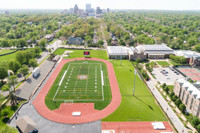
2021 © Washington University in St. Louis 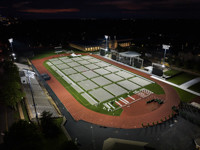
2025 © Washington University in St. Louis 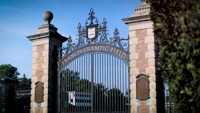
2019 © Washington University in St. Louis 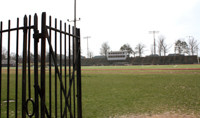
17.03.2010 © Phil Roeder (CC BY 2.0) 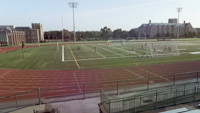
2019 © Washington University in St. Louis 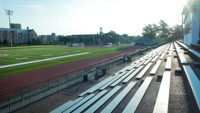
2019 © Washington University in St. Louis 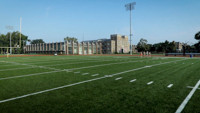
2019 © Washington University in St. Louis 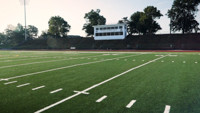
2019 © Washington University in St. Louis 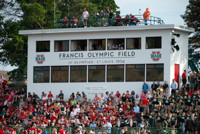
2019 © Washington University in St. Louis 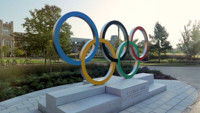
2019 © Washington University in St. Louis 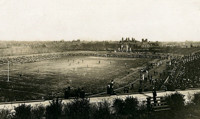
1914 © Washington University in St. Louis 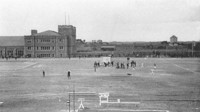
1904 © 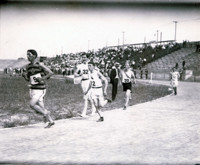
1904 ©
1914:
1904:
 StadiumDB
StadiumDB